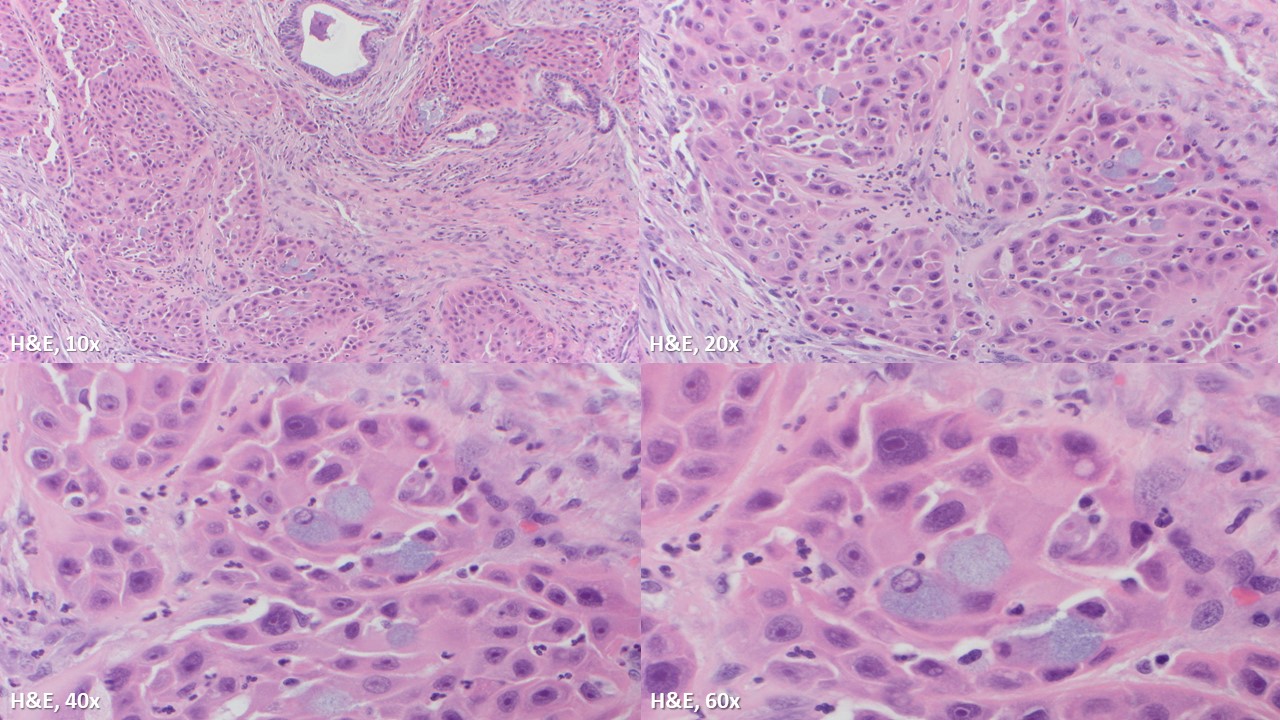Case History
A 73-year-old female with a left parotid mass. Fine needle aspirate. What is the best cytomorphologic diagnosis?
- Pleomorphic adenoma
- Adenoid cystic carcinoma
- High-grade mucoepidermoid carcinoma
- Mammary analogue secretory carcinoma




The answer is “C. High-grade mucoepidermoid carcinoma”
Discussion:
The specimen is cellular and consists of clusters and sheets of large atypical cells with macronucleoli and moderate amounts of somewhat dense cytoplasm. Occasional cells appear to have intracellular mucin and represent muciphages. Scattered benign ductal cells and acini are noted. Necrosis is absent. These findings are consistent with a high-grade salivary gland neoplasm, and a high-grade mucoepidermoid carcinoma is favored on cytology. Subsequent resection confirmed the cytomorphologic impression and showed also perineural invasion.
Mucoepidermoid carcinoma is the most common salivary gland malignancy in children and adults, and the most common malignancy of major and minor salivary glands. Low-grade tumors are more commonly cystic, while high-grade tumors are solid and infiltrative. The diagnostic feature is the combination of mucous cells, epidermoid/squamoid cells, and intermediate cells (which resemble squamous metaplastic cells). High-grade mucoepidermoid carcinomas have a greater proportion of squamoid cells with more cytologic atypia.
Pleomorphic adenoma is the most common tumor in all salivary glands, and the most common site is the superficial parotid. Cytomorphologically, there are epithelial and myoepithelial cells, embedded in fibrillary and chondromyxoid matrix.
Adenoid cystic carcinoma occurs at a higher frequency in the submandibular gland, and has a protracted but poor clinical course. The cells are basaloid, with scant cytoplasm and hyperchromatic, often angulated, nuclei. Nucleoli, mitoses, and necrosis are not prominent except in rare high-grade cases. Most tumors have abundant extracellular matrix that is arranged in discrete globules and cylinders with sharp borders.
Mammary analogue secretory carcinoma is a rare neoplasm that resembles secretory carcinoma of the breast. It occurs more commonly in the parotid of older men. It is characterized by dispersed or loosely cohesive population of cells in papillary or pseudopapillary arrangement. The nuclei are uniform, round and often eccentrically placed, with abundant vacuolated cytoplasm.
Ref: Cibas ES, Ducatman BS. Cytology : Diagnostic Principles and Clinical Correlates. 4th ed. Philadelphia, PA: Saunders/Elsevier; 2014.
Case contributed by Frida Rosenblum, M.D., Assistant Professor, Anatomic Pathology, UAB Department of Pathology
